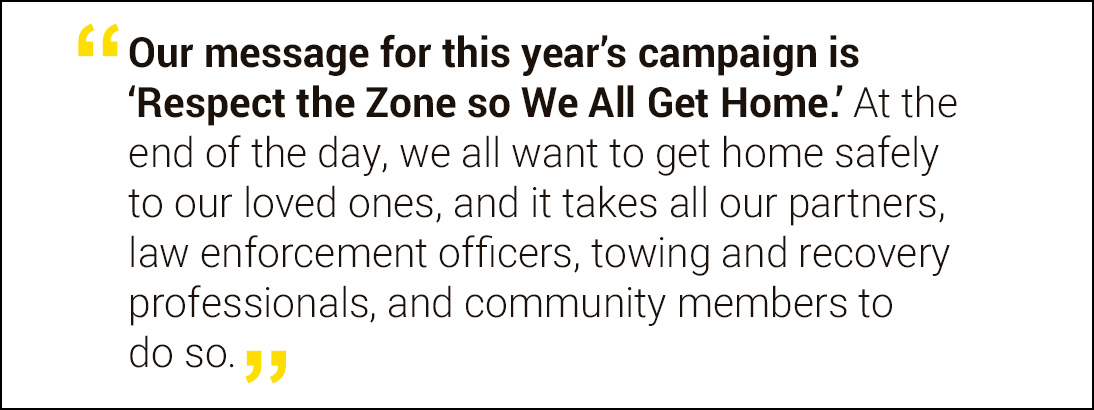At Flagger Force, we are Safety-Driven® and focused on ensuring our team members, clients, motorists, and community members get home to their loved ones at the end of every day. Through our dedicated efforts to educate motorists, increase awareness of work zone safety, advocate for stringent laws and proper enforcement, and partner with organizations who share similar safety goals, we can enhance work zone safety, protect roadway workers, and prevent tragic accidents from occurring across the United States.
Each year, Flagger Force recognizes National Work Zone Awareness Week, an observance held at the start of construction season to encourage safe driving through work zones. From hosting and participating in events to collaborating with industry partners and offering employees special training courses, we strive to use this timely and important observance to amplify our efforts to engage and educate team members, clients, and motorists about the important role they play in keeping work zones safe and our communities moving. This year’s National Work Zone Awareness Week campaign and activities will be hosted by the North Carolina Department of Transportation (NCDOT) from Monday, April 21 to Friday, April 25. We recently had the opportunity to connect with Mark Ezzell, Dr. Cheryl Leonard, and Lindsay Poe from NCDOT to learn more about their safe driving programs, the positive impact their efforts have had across communities, innovative work zone technology, and their planned activities for National Work Zone Awareness Week.
Mark Ezzell is the Director of the North Carolina Governor’s Highway Safety Program. In this role, he leads a group of dedicated professionals working to reduce traffic deaths and injuries across North Carolina by funding local and state safety programs and coordinating state highway safety policy initiatives. Mark also serves as North Carolina Governor’s Representative for Highway Safety. Dr. Cheryl Leonard serves as Assistant Director of External Affairs for NCDOT’s Governor’s Highway Safety Program. She plans and oversees community engagement programs, and Lindsay Poe, NCDOT’s Transportation Safety Communications Officer, is responsible for marketing, events, social media, and earned media.
Read what Mark, Cheryl, and Lindsay shared during our recent conversation to learn how North Carolina is keeping their roadways and community members safe.
What is the mission of the Governor’s Highway Safety Program?
Mark: Our mission is to eliminate traffic crashes in North Carolina by changing behaviors. It is a big mission, especially to eliminate fatalities related to traffic crashes across the state. We carry out our mission in three ways. The first is by providing grant funding. We receive funds from the National Highway Traffic Safety Administration and then administer and provide grants to local and state entities working to prevent traffic crashes, especially those caused by specific driving behaviors. The second piece is implementing public engagement campaigns and increasing awareness. Some of the initiatives we are well known for are our law enforcement activities around impaired driving and occupant protection. The Click It or Ticket campaign originated in our office in the early ‘90s and then the Booze It and Lose It campaign in the mid-‘90s. The third thing we do to carry out our mission is research and advisory work around policies, practices, and laws that can help reduce and eliminate fatal crashes in the state.
What are the primary safe driving campaigns that are part of the Governor’s Highway Safety Program?
Mark: As I mentioned, the Click It or Ticket and Booze It and Lose It campaigns have a long history in our state. Both initiatives were started as a partnership between the Governor’s Highway Safety Program, the insurance industry, and our law enforcement partners. As part of each initiative, during high visibility times (e.g., the holiday season), we put together a campaign and engage law enforcement agencies of all sizes across the state to be on high alert to keep our roadways safe by removing impaired drivers or looking for those who are not wearing their seat belts. The Click It or Ticket and Booze It and Lose It campaigns have combined the enforcement piece with communication efforts that help increase awareness of key issues.
Additionally, we have similar campaigns and efforts to address pedestrian safety across North Carolina. If specific needs are brought to our attention through data, we put together initiatives to address those issues. We also work with other organizations that have an interest in addressing particular traffic safety needs in their communities.
Is there data available that demonstrates the importance and effectiveness of the safe driving campaigns?
Mark: When the Click It or Ticket campaign started, the seat belt use rate in North Carolina was a little over 50%. After three years of the campaign’s implementation, it jumped to 81%. In 2024, we conducted our annual survey to determine the seat belt use rate across the state, and it is now close to 93%. Clearly, the messaging we have shared as part of the Click It or Ticket campaign has been effective.
We also do a lot of policy work. Approximately 20 years ago, we worked to bring about a graduated driver’s licensing process in the state. Basically, young people must go through steps and gradually gain more exposure to different driving conditions to get their license. This process has significantly decreased the number of young people involved in fatal crashes across North Carolina by almost 40%. Finally, we do some concentrated work in specific counties where data shows we have a real problem with traffic crashes. Robinson County is our largest in the state. The area is rural, and there is a lot of poverty. We have concentrated efforts in Robinson County to address driving behaviors and prevent traffic crashes. Last year, we saw the traffic fatality rate in the area decrease by 36%. These are just a few examples of how we have been able to target our efforts and make a difference.

Do you have data that shows the number of work zone crashes, injuries, and/or deaths that have occurred in North Carolina in recent years?
Lindsay: Between 2019 and 2024 in North Carolina, 39,919 work zone crashes resulted in 217 fatalities. In 2024, 47 people were killed in North Carolina work zones, including two workers, eight pedestrians, and 37 motorists.

What current efforts is the North Carolina Department of Transportation implementing to improve work zone safety and prevent tragic incidents across the state?
Cheryl: There are technical steps the North Carolina Department of Transportation is taking to reduce work zone crashes. For example, we have increased device visibility for our major interstate and road construction sites. We require the traditional 36-inch cones as well as newer versions of the skinny drums, which are taller and more visual. We put higher-grade fluorescent sheeting on our drums and other stationary equipment, so drivers can see them from an increased distance and in harsh conditions. We have also made big improvements in eliminating ghost lines from previous road patterns and installing high-performance pavement markings, which are much more visible in work zones. Additionally, we have tightened up our cone and skinny drum spacing to increase the number of devices used on a project so our contractors can install other devices more consistently and ensure the motoring public sees those devices that are upright, warning drivers where to go and how to navigate through the work zone.
Low light conditions can make it difficult for drivers to navigate areas where the road may have a turn or lane shift due to the construction work that is being done. We want to make sure they have the best possible visual of the roadway, so we often use sequential flashing warning lights on our nighttime lane closures. We also focus on educating the public and ensuring they adhere to the posted and advisory speed limits and all warning signs, even if the work zone is not active. This is because there is construction underway and the road may be bumpier than normal or there may be stationary equipment that could be hit, so reducing speed helps to keep motorists and their passengers safe.
North Carolina has been a national leader when it comes to piloting new work zone technology that can enhance safety. One of the most interesting trends is how our law enforcement agencies, particularly the state highway patrol, uses message boards with flashing blue lights. The technology reacts based on the speed of passing vehicles, displaying active blue lights and safety messages. Other technology we use can record the speed at which vehicles are traveling through a work zone. We have law enforcement officers working with our contractors in the work zones to stop people who are traveling at a greater speed than they should be and educate them on the benefits of being more cautious and slowing down. We also use dynamic zipper merge and queue warning systems so that motorists are aware of what they need to do to safely navigate work zones. We are proud of our technology and are always evaluating what we can do differently to protect our community members and roadway workers.
What does it mean to the North Carolina Department of Transportation to be the host of the 2025 National Work Zone Awareness Week campaign?
Cheryl: The North Carolina Department of Transportation (NCDOT) is hosting the 2025 National Work Zone Awareness Week (NWZAW) campaign in collaboration with the American Traffic Safety Services Association. We have been working toward becoming the host for several years. It is a very competitive process. NCDOT submitted a proposal last year detailing all our efforts from an education, technical, and legislative standpoint to improve work zone safety. Our proposal was reviewed and NCDOT was selected as the host state for this year’s activities. This accomplishment means so much to NCDOT as well as our partners across the state, including all our law enforcement agencies, school systems, health departments, and first responders. We have an opportunity to tell the nation that North Carolina is focused on enhancing roadway safety through advocacy, training, and strategic partnerships as well as reducing injuries and fatalities on our state’s roadways. While we look forward to highlighting all North Carolina has done and continues to do to improve work zone safety, NWZAW extends beyond our state. It is a national effort that brings key stakeholders to the table to show their commitment to work zone safety not only in North Carolina but across the entire United States.
Mark: By some measures, North Carolina is the fastest growing state in the United States, and we have the second-largest road network in the country. These two factors have made work zones really explode in North Carolina as critical infrastructure improvements are made to create new roads and repair existing ones. This recognition, to some degree, highlights the work North Carolina has done in maintaining and continuing to build a quality road system. Being the host of this year’s NWZAW campaign is an opportunity to showcase what we have done to maintain safety within those work zones. We are pleased to have the opportunity to bring together different state, local, and national partners for this very important event. We know it is a nationwide problem, but we are happy to highlight what we are doing in North Carolina.
What role does collaboration with businesses, safety professionals, law enforcement, elected officials, and community members play in the North Carolina Department of Transportation’s ability to enhance work zone safety?
Mark: It is key. We do a lot of work around the behavioral aspects of traffic safety, and that is important. But we also must consider the roadway design and enforcement of laws. When it comes to traffic deaths, be it in work zones or anywhere else, we cannot educate our way out of it, we cannot design our way out of it, and we cannot enforce our way out of it. What we can do is combine all these factors together to make a difference and that is what we are trying to do across the state.
Are there specific driving behaviors that will be important to address during National Work Zone Awareness Week?
Mark: I feel two driving behaviors need to be highlighted. One is speeding in work zones. So many people fail to abide by the reduced speed limits and that can be incredibly deadly. Think about an unprotected roadway worker going up against a vehicle traveling at 60 or 70 MPH – it is not a fair fight. We must make sure people adhere to the posted speed limits in work zones, which means increasing awareness, enforcement, and technology that forces motorists to slow down. The second thing that people need to do in work zones, and all the time, is pay attention. Lack of attention or distracted driving is something we see quite a bit on our roadways. It is a hard behavior to change, but it is one we really need to get a handle on to prevent tragedies. Those are the two behaviors I would absolutely highlight, in addition to other actions we see, such as failure to wear a seatbelt and impaired driving, whether that be with alcohol, drugs, or prescription medications.
What activities or initiatives does the North Carolina Department of Transportation have planned during National Work Zone Awareness Week to increase awareness of work zone safety and the importance of safe driving behaviors?
Cheryl: National Work Zone Awareness Week (NWZAW) will take place Monday, April 21 to Friday, April 25, 2025. We will be hosting a kickoff event on Tuesday, April 22, with our partners, key stakeholders nationwide, and local media. On Wednesday, April 23, we are planning a Go Orange Day and encouraging all our partners and legislators to wear orange and post pictures on their social media channels. Then, on Thursday, April 24, we are requesting that our law enforcement partners go out into their communities and help to spread the work zone safety message. We will reiterate that work zones are not only on major thoroughfares, but also rural areas and two-lane roads. The message will be spread through active law enforcement efforts and on social media.
While National Work Zone Awareness Week takes place in April, it is important to note that work zone safety applies all year round. As the weather warms up and the days get longer, drivers will see an increase in work zones, so it is important they are mindful of their driving behaviors all the time.
What safety message would you like to share with community members ahead of National Work Zone Awareness Week?
Lindsay: We want everyone to take work zone safety seriously. Even one person killed is too many and we want to keep our roadways safe. As Mark mentioned, we are a growing state and with that comes the need for roadway maintenance and expansion. We ask for patience because it takes time to build safe roadways.
It is a honor to be hosting National Work Zone Awareness Week. Our message for this year’s campaign is “Respect the Zone so We All Get Home.” At the end of the day, we all want to get home safely to our loved ones, and it takes all our partners, law enforcement officers, towing and recovery professionals, and community members to do so.

Is there anything else about the North Carolina Department of Transportation’s programs or efforts that you would like to share?
Mark: Improving work zone safety is not something that the North Carolina Department of Transportation or Governor’s Highway Safety Program is doing alone. This is a statewide effort involving a lot of different partners, including other agencies, associations, and businesses like Flagger Force. Flagger Force has been a real leader in addressing work zone safety issues across the state because their team has been affected and feels it personally. It is not even simply a transportation issue. It is a public health issue, education issue, and one that touches a lot of people in many ways.
Cheryl: It is important that we honor and remember the people who have given their lives while making our roadways safer. We have a traveling memorial with the names of individuals who have been killed in work zone-related incidents. We have been working behind the scenes to connect with our DOT employees, contractors, and community members to raise awareness of the memorial so that if they know someone who has been tragically killed in a work zone, they can reach out to have that individual recognized.
Flagger Force would like to thank the North Carolina Department of Transportation for all their efforts to educate motorists and increase safety on the state’s roadways and in work zones. We thank Mark Ezzell, Dr. Cheryl Leonard, and Lindsay Poe for participating in this insightful discussion and sharing details about NCDOT’s programs, work zone safety technology, and National Work Zone Awareness Week activities. At Flagger Force, we are committed to improving work zone safety in North Carolina, across our entire geographic footprint, and around the nation. We are honored to partner with professionals and organizations, like NCDOT, who share our drive to protect roadway workers, prevent work zone tragedies, and ensure we keep our communities moving safely. The Flagger Force team looks forward to working with NCDOT during the 2025 National Work Zone Awareness Week to help spread critical work zone safety messaging!

